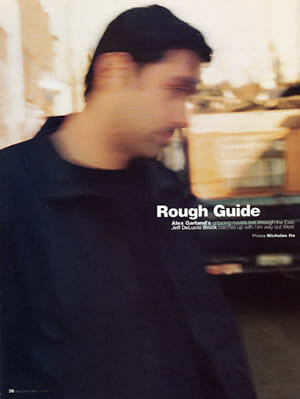AUTHOR ALEX GARLAND first witnessed the intersection of pop culture and native lifestyles during a six-month visit to the Philippines at age 18. The idea of “culture” struck him as something increasingly cosmetic then, and the attitude has stuck with him since.
“On the one hand, I’m saying [with my books] that culture is basically unimportant … it’s not something that should be kept in this anachronistic state for the benefit of Western tourists with a backpack who have some sense of moral superiority,” says Garland, author of two critically acclaimed novels set in Southeast Asia.
“The PC side of it is that … despite being in what was claimed to be a very different culture (in the Philippines), the preoccupations of people (I met) were exactly the same. I was hanging out with 18-year-old guys who lived in true rural poverty on an island in the Philippines. They were worried about girls, and having an argument with their best friend. That was stuff I was quite used to worrying about.”
The 29-year-old author — who explores the PC and non-PC sides of culture in his novels The Beach and The Tesseract — is now finding himself at the center of worldwide attention. The Beach, his debut novel, is being made into the film that Leonardo DiCaprio chose as his long-awaited follow-up to Titanic. But although Garland is quite photogenic, the Brit has had little interaction with the celebrity world and had never even been to Hollywood until a couple of days before this interview.
Unassuming and modest — but not cloying — Garland relishes his relative anonymity and hates to give public readings. “I get nervous,” Garland says, hours before a San Francisco reading to promote The Tesseract. “I don’t act like myself.”
Although the phrase “Generation X” is mentioned numerous times in The Beach’s dust jacket blurbs. Garland’s works do not strive to be name-dropping, self-consciously hip tomes. The Beach — with key pop-culture references such as Nintendo Game Boy and the film Platoon — is reflective of its time yet does not pander to it.
Generation X, Garland says, is a term used by 45-year-olds, and one of its defining characteristics is an overuse of irony. “Irony is incredibly prohibitive in terms of passion or enthusiasm,” he says. “I’m much too interested in enthusiasm and passion to feel very connected to Generation X stuff.”
Inspired by his cartoonist father, Garland first learned how to assemble a narrative by drawing comic strips, starting at age 12. He didn’t begin writing until age 21, and taught himself by emulating other writers. While writing dialogue is easy for Garland, what comes least naturally is extended prose description. “Often my temptation is to say, ‘It’s a bar, there’s some seats.’ You’ve seen a bar. What are the people saying in the bar?” he says.
In The Beach, Garland effectively explores group dynamics — a kind of playground politics, why some people are drawn into groups and others are kept permanently isolated. The narrative revolves around a backpacker  named Richard who is given a map to a remote Thailand beach by a man who then kills himself. Richard and two traveling companions discover The Beach, and with it an idyllic community of fellow travelers. The place slowly unravels under the pressure of its isolation, though. Compulsively page turning, the book is filled with dead-on observations of everyday life. Garland had no idea the book would attract such a large audience.
named Richard who is given a map to a remote Thailand beach by a man who then kills himself. Richard and two traveling companions discover The Beach, and with it an idyllic community of fellow travelers. The place slowly unravels under the pressure of its isolation, though. Compulsively page turning, the book is filled with dead-on observations of everyday life. Garland had no idea the book would attract such a large audience.
“Later, I read a piece in an English newspaper that said The Beach was clearly a very cynically constructed thing to [attract] this backpacker demographic,” Garland says. “Given what I now know about the industry, to think I could have sat down at age 23 with this ‘brilliant’ cynical marketing plan designed to ultimately end up with a Leonardo DiCaprio film is completely fucking insane.”
The methodical thinking of some Hollywood execs was foreign to Garland. When he and his agent were considering which filmmaker’s offer to accept, one studio type told Garland, “We’ll need to change the story — that’s just the way it is.” Garland recalls, “He talked about having nuclear waste buried on the island, explaining why people were reacting so strangely. I was thinking, ‘Christ, this is like every cliche I’ve ever heard about the film industry coming true.’ Like there aren’t plenty of reasons for an isolated, slightly manic community to go crazy.”
Garland successfully fought for Danny Boyle to direct the film. Garland admired Boyle’s work on the films Shallow Grave and Trainspotting and Garland says the script reads well.
The Tesseract, which Garland started the day after he finished The Beach, is surprisingly different from its predecessor. Named and modeled after the hypothetical, fourth-dimensional cube that can be imagined but not fully grasped by three-dimensional minds, its masterful, intricate structure brings together lives from three very different Filipino worlds — organized crime, the middle class, and homeless street kids — and examines how they respond to random, life-changing events.
Because The Beach didn’t come out until a year after he began The Tesseract, Garland was spared some of the expected sophomore follow-up pressure. Still, at times, a sense of uncertainty seized him: “Was there something in The Beach I didn’t realize I was doing, some secret trick I’d hit upon?”
The Tesseract is filled with unexpectedly touching moments, and it contains the passage of which he feels most proud from his work: a Filipino woman in her early 30s remembers a love affair she had at age 16 with a boy in the provinces.
“Writing about ugliness or horror is pretty easy — they’re easy buttons to push,” says Garland, who is still pondering his plans for his third novel. “But something which is more reflective, or about beauty or human emotions, is a very difficult thing to get across.”


